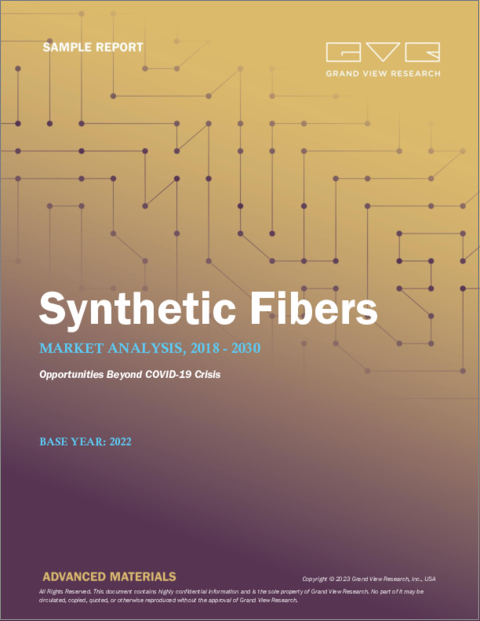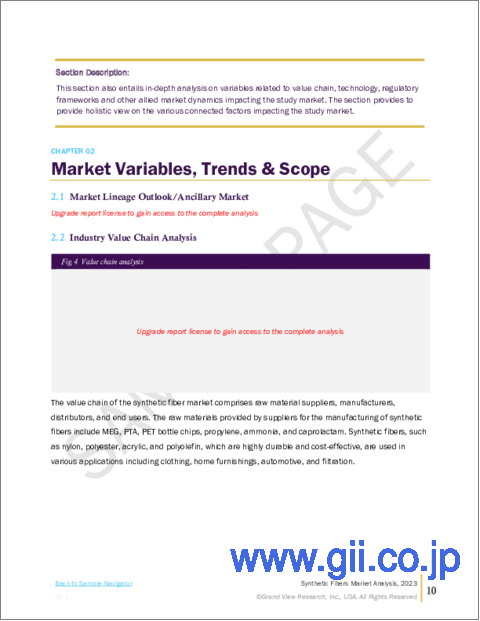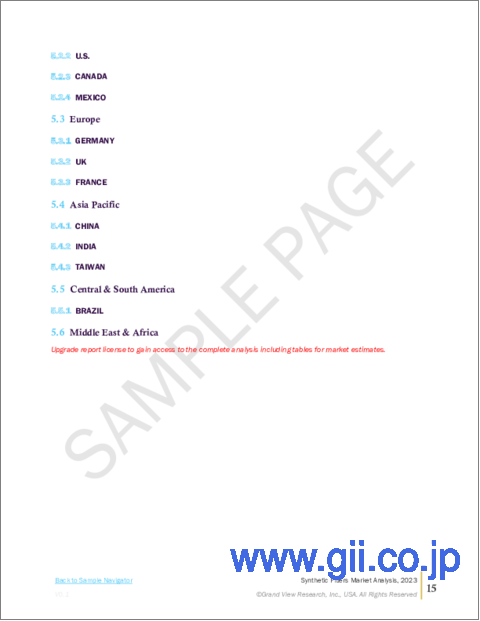|
|
市場調査レポート
商品コード
1268783
合成繊維の市場規模、シェア、動向分析市場:タイプ別(アクリル、ポリエステル、ナイロン)、用途別(衣料、ホームファニシング、ろ過)、地域別、セグメント別予測、2023~2030年Synthetic Fibers Market Size, Share & Trends Analysis Report By Type (Acrylics, Polyester, Nylon), By Application (Clothing, Home Furnishing, Filtration), By Region, And Segment Forecasts, 2023 - 2030 |
||||||
|
● お客様のご希望に応じて、既存データの加工や未掲載情報(例:国別セグメント)の追加などの対応が可能です。 詳細はお問い合わせください。 |
|||||||
| 合成繊維の市場規模、シェア、動向分析市場:タイプ別(アクリル、ポリエステル、ナイロン)、用途別(衣料、ホームファニシング、ろ過)、地域別、セグメント別予測、2023~2030年 |
|
出版日: 2023年04月10日
発行: Grand View Research
ページ情報: 英文 145 Pages
納期: 2~10営業日
|
- 全表示
- 概要
- 図表
- 目次
合成繊維の市場成長と動向:
Grand View Research, Inc.の最新レポートによると、世界の合成繊維市場規模は2030年までに1,177億6,000万米ドルに達し、7.4%のCAGRを記録すると予測されています。
費用対効果が高く、耐久性があり、洗濯やメンテナンスが容易な合成繊維に対する消費者の需要の高まりが、予測期間中の市場成長を促進すると予想されます。
ファッション動向の変化と、近代的な生活水準を持つ都市人口の増加が、ハイエンドのポリエステル繊維のビジネスチャンスにつながると期待されています。合成繊維は繊維産業で広く使用されており、天然繊維と比較して優れた特性を示しています。したがって、合成繊維の市場は、繊維産業の拡大とともに成長すると予想されます。
アクリル、ポリエステル、ナイロン、レーヨンなどの合成繊維から作られた生地は、衣料品分野の様々な用途に使用されています。これらの生地は、丈夫で耐久性があり、染色が容易で、柔らかく、高吸水性素材として機能します。生産設備のデジタル化や新興国における繊維産業の成長といった要因が、予測期間中の市場成長を加速させると予想されます。
アジア太平洋は合成繊維の最大市場であり、人口密度が高く、自動車、繊維、ろ過、家具などの分野で合成繊維製品のニーズが高まっているため、予測期間を通じて需要が増加すると思われます。この地域の経済成長、特にインドと中国では、合成繊維の需要が増加することが予想されます。H&M、Zara、Dior、Louis Vuitton、Gucci、Hermesなどの大手多国籍ファッション衣料メーカーの存在により、ブランド衣料への需要が高まり、それが同国の合成繊維市場の需要に貢献すると予想されます。
合成繊維市場では、多くの企業が参入しているため、競争企業間の敵対関係が激しくなっています。競争優位に立つために、多くの企業が新製品の発売、合併、ポートフォリオの強化、さまざまな技術的進歩への対応など、さまざまな戦略を採っています。
合成繊維市場のレポートハイライト
- ポリエステルタイプは2021年に305億3,000万米ドルを占め、2022年から2030年にかけてCAGR5.0%で成長すると予測されます。この成長は、テキスタイル、ホームファニシング、布張りの生産における応用に起因すると考えられます。
- eコマース産業の拡大により、さまざまなスポーツアパレル小売業者が、軽量で吸湿発散性のあるスポーツウェアやジムウェアなどの製品を提供する機会を得ています。このことが、予測期間中にポリエステル繊維の需要を押し上げると思われます。
- 2022年、衣料品用途は46.7%の収益シェアを占めました。これは、フィットネスへの関心が高まっている都市部の人々のジム用衣料品への需要が増加しているためです。ライフスタイルの改善や消費者の消費能力の向上が、衣料品への需要をさらに促進しており、合成繊維市場に成長機会をもたらすと予想されます。また、ファッション動向の変化と人工シルクの需要増が相まって、市場成長を後押しすると期待されています。
- 消費者の消費能力の向上と、より良いインテリアへの憧れにより、これらの地域ではホームファニシングのニーズが高まると予測されます。ホームファニシングの成長は、予測期間中、合成繊維の需要の増加をもたらすと予想されます。
- アジア太平洋は、2022年から2030年にかけて5.5%の大幅な市場成長を遂げると予測されます。同地域のアパレル・繊維産業は、合成繊維の需要を増大させると予想される大型プロジェクトにおける各国政府別インフラ投資の増加により、今後数年間で大きな成長を遂げると予想されます。
- 主要な市場関係者は、事業領域の拡大や生産能力の増強のために合併や提携を行い、市場シェアを高めています。さらに、ポリエステルの生産と合成繊維のリサイクルにおける画期的な進歩は、すべての環境問題を解決するものではないため、各社は環境問題を克服するために研究開発に多額の投資を行っています。
目次
第1章 調査手法と範囲
- 市場セグメンテーションと範囲
- 市場の定義
- 情報調達
- 購入したデータベース
- GVRの内部データベース
- 二次情報と第三者の視点
- 1次調査
- 情報分析
- データ分析モデル
- 市場の形成とデータの視覚化
- データの検証と公開
第2章 エグゼクティブサマリー
- 市場の見通し
- セグメント別の見通し
- 競合考察
第3章 市場変数、動向、および範囲
- 市場系統の見通し
- 業界のバリューチェーン分析
- 主要原材料動向分析
- 規制の枠組み
- テクノロジーフレームワーク
- 合成繊維市場-市場力学
- 市場促進要因の分析
- 市場抑制要因分析
- 業界の課題
- ビジネス環境ツール分析:合成繊維市場
- ポーターのファイブフォース分析
- 供給企業の交渉力
- 買い手の交渉力
- 代替の脅威
- 新規参入業者の脅威
- 競争企業間の敵対関係
- SWOT別PESTLE分析
- 政治的情勢
- 経済情勢
- 社会的情勢
- テクノロジーの情勢
- 環境情勢
- 法的情勢
- 市場ディスラプション分析
- ポーターのファイブフォース分析
第4章 合成繊維市場:種類の推定・動向分析
- 合成繊維市場:タイプの重要なポイント
- 合成繊維市場:物質変動分析、2022年および2030年
- ポリエステル
- ナイロン
- アクリル
- ポリオレフィン
- その他
第5章 合成繊維市場:用途推定・動向分析
- 合成繊維市場:用途の重要なポイント
- 合成繊維市場:用途変動分析、2022年および2030年
- 衣類
- 家財道具
- 自動車
- 濾過
- その他
第6章 合成繊維市場:地域推定・動向分析
- 合成繊維市場:地域別の重要なポイント
- 合成繊維市場:地域変動分析、2022年および2030年
- 北米
- 米国
- カナダ
- メキシコ
- 欧州
- ドイツ
- 英国
- フランス
- アジア太平洋地域
- 中国
- インド
- 台湾
- 中南米
- ブラジル
- 中東とアフリカ
- 市場推計・予測、2018~2030年
第7章 競合情勢
- 主要な世界的プレーヤー、その取り組み、市場への影響
- ベンダー情勢
- 企業の市況分析
- 企業ダッシュボード分析
- 戦略の枠組み
- 企業リスト(概要、財務、製品ポートフォリオ、戦略)
- Bombay Dyeing
- 会社概要
- 財務実績
- 製品のベンチマーク
- 戦略的取り組み
- EI du Pont de Nemours and Company
- Indorama Corporation
- Lenzing AG
- Mitsubishi Chemical Holdings Corporation
- Reliance Industries Limited
- China Petroleum Corporation(Sinopec Corp.)
- Teijin Limited
- Toray Chemical Korea, Inc.
- Toyobo Co., Ltd.
- Bombay Dyeing
List of Tables
- Table 1 Synthetic fibers estimates and forecasts, by Type 2018 - 2030 (Kilotons)
- Table 2 Synthetic fibers estimates and forecasts, by Type 2018 - 2030 (USD Million)
- Table 3 Synthetic fibers estimates and forecasts, by Application 2018 - 2030 (Kilotons)
- Table 4 Synthetic fibers estimates and forecasts, by Application 2018 - 2030 (USD Million)
List of Figures
- Fig. 1 Market segmentation & scope
- Fig. 2 Penetration & growth prospect mapping
- Fig. 3 Value chain analysis
- Fig. 4 Market dynamics
- Fig. 5 Market trends and outlook
- Fig. 6 Market driver relevance analysis (Current & future impact)
- Fig. 7 Porter's Five Forces Analysis
- Fig. 8 PESTEL Analysis
- Fig. 9 Synthetic fiber market: Type movement analysis, 2022 & 2030
- Fig. 10 Polyester synthetic fibers market estimates and forecasts, 2018 - 2030 (Kilotons) (USD Million)
- Fig. 11 Nylon synthetic fibers market estimates and forecasts, 2018 - 2030 (Kilotons) (USD Million)
- Fig. 12 Acrylics synthetic fibers market estimates and forecasts, 2018 - 2030 (Kilotons) (USD Million)
- Fig. 13 Polyolefins synthetic fibers market estimates and forecasts, 2018 - 2030 (Kilotons) (USD Million)
- Fig. 14 Synthetic fibers market estimates and forecasts, by other materials, 2018 - 2030 (Kilotons) (USD Million)
- Fig. 15 Synthetic fiber market: Application movement analysis, 2022 & 2030
- Fig. 16 Synthetic fibers estimates and forecasts for clothing, 2018 - 2030 (Kilotons) (USD Million)
- Fig. 17 Synthetic fibers estimates and forecasts for home furnishing, 2018 - 2030 (Kilotons) (USD Million)
- Fig. 18 Synthetic fibers estimates and forecasts for automotive, 2018 - 2030 (Kilotons) (USD Million)
- Fig. 19 Synthetic fibers estimates and forecasts for filtration, 2018 - 2030 (Kilotons) (USD Million)
- Fig. 20 Synthetic fibers estimates and forecasts for other applications, 2018 - 2030 (Kilotons) (USD Million)
- Fig. 21 Regional marketplace: Key takeaways
- Fig. 22 Regional outlook, 2022 & 2030
- Fig. 23 North America synthetic fibers estimates and forecasts, 2018 - 2030 (Kilotons) (USD Million)
- Fig. 24 U.S. synthetic fibers estimates and forecasts, 2018 - 2030 (Kilotons) (USD Million)
- Fig. 25 Canada synthetic fibers estimates and forecasts, 2018 - 2030 (Kilotons) (USD Million)
- Fig. 26 Mexico synthetic fibers estimates and forecasts, 2018 - 2030 (Kilotons) (USD Million)
- Fig. 27 Europe synthetic fibers estimates and forecasts, 2018 - 2030 (Kilotons) (USD Million)
- Fig. 28 Germany synthetic fibers estimates and forecasts, 2018 - 2030 (Kilotons) (USD Million)
- Fig. 29 U.K. synthetic fibers estimates and forecasts, 2018 - 2030 (Kilotons) (USD Million)
- Fig. 30 France synthetic fibers estimates and forecasts, 2018 - 2030 (Kilotons) (USD Million)
- Fig. 31 Asia Pacific synthetic fibers estimates and forecasts, 2018 - 2030 (Kilotons) (USD Million)
- Fig. 32 China synthetic fibers estimates and forecasts, 2018 - 2030 (Kilotons) (USD Million)
- Fig. 33 India synthetic fibers estimates and forecasts, 2018 - 2030 (Kilotons) (USD Million)
- Fig. 34 Taiwan synthetic fibers estimates and forecasts, 2018 - 2030 (Kilotons) (USD Million)
- Fig. 35 Central & South America synthetic fibers estimates and forecasts, 2018 - 2030 (Kilotons) (USD Million)
- Fig. 36 Brazil synthetic fibers estimates and forecasts, 2018 - 2030 (Kilotons) (USD Million)
- Fig. 37 Middle East & Africa synthetic fibers estimates and forecasts, 2018 - 2030 (Kilotons) (USD Million)
- Fig. 38 Strategy mapping of key market players
Synthetic Fibers Market Growth & Trends:
The global Synthetic Fibers market size is expected to reach USD 117.76 billion by 2030, registering a CAGR of 7.4% according to a new report by Grand View Research, Inc. Increasing consumer demand for cost-effective, durable, and easy-to-wash & maintainable synthetic fabrics is expected to drive the market growth during the forecast period.
The shifting fashion trends coupled with the rising urban population with modern living standards are expected to provide opportunities for high-end polyester fibers. Synthetic Fibers have been extensively used in the textile industry and exhibit superior properties as compared to natural fibers. Thus, the market for Synthetic Fibers is anticipated to grow with the expansion of the textile industry.
Fabrics produced from Synthetic Fibers, such as acrylics, polyester, nylon, and rayon, are used in an array of applications in the clothing segment. These fabrics are strong, durable, easy to dye, & soft, and act as a highly absorbent material. The factors like the digitalization of production facilities and the growing textile industry in emerging economies are expected to surge market growth during the forecasted period.
Asia Pacific is the largest market for Synthetic Fibers, with demand likely to rise throughout the forecast period due to the region's high population density and rising need for Synthetic Fibers products in sectors such as automotive, textile, filtration, and furniture. The region's growing economies, particularly India and China, will see an increase in demand for Synthetic Fibers. The presence of major multinational fashion clothing manufacturers, including H&M, Zara, Dior, Louis Vuitton, Gucci, and Hermes, has increased the demand for branded clothing, which, in turn, is anticipated to benefit the demand for Synthetic Fibers market in the country.
The Synthetic Fibers market exhibits a large number of players in the market resulting in high competitive rivalry. To gain a competitive edge many companies are adopting various strategies such as new product launches, mergers, enhancing portfolios, and adapting various technological advancements.
Synthetic Fibers Market Report Highlights:
- The polyester type segment accounted for USD 30.53 billion in 2021 and is projected to grow at a CAGR of 5.0% from 2022 to 2030. The growth can be attributed to its application in the production of textiles, home furnishing, and upholstery.
- The escalating e-commerce industry has provided opportunities to different sports apparel retailers to offer products like sports and gym clothing which are lightweight and have moisture-wicking properties. This is likely to boost the demand for polyester fiber during the forecast period.
- Clothing applications accounted for the revenue share of 46.7% in 2022 on account of the growing demand for gym apparel in the urban population regarding their increasing focus on fitness. The lifestyle improvements and increasing spending capacity of the consumer are further driving the demand for apparel, which is expected to provide growth opportunities to the Synthetic Fibers market. In addition, changing fashion trends coupled with the rising demand for artificial silk are expected to boost the market growth.
- The increase in spending capability of consumers and aspiration for better-looking interiors are projected to boost the need for home furnishings in these regions. The growth in home furnishings is, in turn, expected to result in the growing demand for Synthetic Fibers during the forecast period.
- The Asia Pacific is projected to witness substantial market growth of 5.5% from 2022 to 2030. The apparel and textile industry in the region is expected to witness significant growth in the coming years owing to the increasing infrastructural investments by different governments in large projects that are expected to augment the demand for synthetic textiles.
- Key market players are undertaking mergers and collaborations to expand their reach and increase production capacity, thereby advancing their market share. Additionally, the players are investing heavily in R&D to overcome environmental concerns, since breakthroughs in polyester production and Synthetic Fibers recycling are not a cure for all environmental issues.
Table of Contents
Chapter 1. Methodology and Scope
- 1.1. Market Segmentation & Scope
- 1.2. Market Definition
- 1.3. Information Procurement
- 1.3.1. Purchased Database
- 1.3.2. GVR's Internal Database
- 1.3.3. Secondary Sources & Third-Party Perspectives
- 1.3.4. Primary Research
- 1.4. Information Analysis
- 1.4.1. Data Analysis Models
- 1.5. Market Formulation & Data Visualization
- 1.6. Data Validation & Publishing
Chapter 2. Executive Summary
- 2.1. Market Outlook
- 2.2. Segmental Outlook
- 2.3. Competitive Insights
Chapter 3. Market Variables, Trends, and Scope
- 3.1. Market Lineage Outlook
- 3.2. Industry Value Chain Analysis
- 3.2.1. Major Raw Material Trends Analysis
- 3.3. Regulatory Framework
- 3.4. Technology Framework
- 3.5. Synthetic Fibers Market - Market Dynamics
- 3.5.1. Market Driver Analysis
- 3.5.2. Market Restraint Analysis
- 3.5.3. Industry Challenges
- 3.6. Business Environmental Tools Analysis: Synthetic Fibers Market
- 3.6.1. Porter's Five Forces Analysis
- 3.6.1.1. Bargaining Power of Suppliers
- 3.6.1.2. Bargaining Power of Buyers
- 3.6.1.3. Threat of Substitution
- 3.6.1.4. Threat of New Entrants
- 3.6.1.5. Competitive Rivalry
- 3.6.2. PESTLE Analysis by SWOT
- 3.6.2.1. Political Landscape
- 3.6.2.2. Economic Landscape
- 3.6.2.3. Social Landscape
- 3.6.2.4. Technology Landscape
- 3.6.2.5. Environmental Landscape
- 3.6.2.6. Legal Landscape
- 3.6.3. Market Disruption Analysis
- 3.6.1. Porter's Five Forces Analysis
Chapter 4. Synthetic Fibers Market: Types Estimates & Trend Analysis
- 4.1. Synthetic Fibers market: Type Key Takeaways
- 4.2. Synthetic Fibers Market: Material Movement Analysis, 2022 & 2030
- 4.3. Polyester
- 4.4. Nylon
- 4.5. Acrylics
- 4.6. Polyolefins
- 4.7. Others
Chapter 5. Synthetic Fibers Market: Application Estimates & Trend Analysis
- 5.1. Synthetic Fibers market: Application Key Takeaways
- 5.2. Synthetic Fibers Market: Application Movement Analysis, 2022 & 2030
- 5.3. Clothing
- 5.4. Home Furnishing
- 5.5. Automotive
- 5.6. Filtration
- 5.7. Others
Chapter 6. Synthetic Fibers Market: Regional Estimates & Trend Analysis
- 6.1. Synthetic Fibers Market: Regional Key Takeaways
- 6.2. Synthetic Fibers market: Regional movement analysis, 2022 & 2030
- 6.3. North America
- 6.3.1. Market estimates and forecasts, 2018 - 2030 (Kilotons) (USD Million)
- 6.3.2. U.S.
- 6.3.2.1. Market estimates and forecasts, 2018 - 2030 (Kilotons) (USD Million)
- 6.3.3. Canada
- 6.3.3.1. Market estimates and forecasts, 2018 - 2030 (Kilotons) (USD Million)
- 6.3.4. Mexico
- 6.3.4.1. Market estimates and forecasts, 2018 - 2030 (Kilotons) (USD Million)
- 6.4. Europe
- 6.4.1. Market estimates and forecasts, 2018 - 2030 (Kilotons) (USD Million)
- 6.4.2. Germany
- 6.4.2.1. Market estimates and forecasts, 2018 - 2030 (Kilotons) (USD Million)
- 6.4.3. U.K.
- 6.4.3.1. Market estimates and forecasts, 2018 - 2030 (Kilotons) (USD Million)
- 6.4.4. France
- 6.4.4.1. Market estimates and forecasts, 2018 - 2030 (Kilotons) (USD Million)
- 6.5. Asia Pacific
- 6.5.1. Market estimates and forecasts, 2018 - 2030 (Kilotons) (USD Million)
- 6.5.2. China
- 6.5.2.1. Market estimates and forecasts, 2018 - 2030 (Kilotons) (USD Million)
- 6.5.3. India
- 6.5.3.1. Market estimates and forecasts, 2018 - 2030 (Kilotons) (USD Million)
- 6.5.4. Taiwan
- 6.5.4.1. Market estimates and forecasts, 2018 - 2030 (Kilotons) (USD Million)
- 6.6. Central & South America
- 6.6.1.1. Market estimates and forecasts, 2018 - 2030 (Kilotons) (USD Million)
- 6.6.2. Brazil
- 6.6.2.1. Market estimates and forecasts, 2018 - 2030 (Kilotons) (USD Million)
- 6.7. Middle East & Africa
- 6.7.1. Market estimates and forecasts, 2018 - 2030 (Kilotons) (USD Million)
Chapter 7. Competitive Landscape
- 7.1. Key Global Players, Their Initiatives, & Their Impact on the Market
- 7.2. Vendor Landscape
- 7.3. Company Market Position Analysis
- 7.4. Company Dashboard Analysis
- 7.5. Strategic Framework
- 7.6. Company Listings (Overview, Financials, Product Portfolio, Strategy)
- 7.6.1. Bombay Dyeing
- 7.6.1.1. Company overview
- 7.6.1.2. Financial performance
- 7.6.1.3. Product benchmarking
- 7.6.1.4. Strategic initiatives
- 7.6.2. E. I. du Pont de Nemours and Company
- 7.6.3. Indorama Corporation
- 7.6.4. Lenzing AG
- 7.6.5. Mitsubishi Chemical Holdings Corporation
- 7.6.6. Reliance Industries Limited
- 7.6.7. China Petroleum Corporation (Sinopec Corp.)
- 7.6.8. Teijin Limited
- 7.6.9. Toray Chemical Korea, Inc.
- 7.6.10. Toyobo Co., Ltd.
- 7.6.1. Bombay Dyeing




